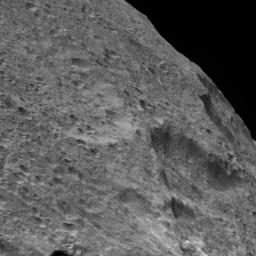
|
Dawn LAMO Image 33
- Click the image above for a larger view
- Full-Res JPEG (1024 x 1024) (123.0 kB)
- Full-Res TIFF (1024 x 1024) (918.9 kB)
Caption:
NASA's Dawn spacecraft captured this view of a region in the mid-southern latitudes of Ceres. The largest crater in the scene is Fluusa (37 miles or 59 kilometers in diameter), which fills the upper left portion of the image. Fluusa has a densely cratered floor and therefore is interpreted as an old impact feature.
The highly oblique viewing angle enhances the topography of the densely cratered landscape, especially along the limb. The smooth, less densely cratered area at bottom is most likely ejecta from a younger crater, possibly those of Juling Crater, located outside the image scene (see PIA20386 ).
The image is centered at approximately 35 degrees south latitude, 174 degrees east longitude. Dawn captured the scene on Jan. 4, 2016, from its low-altitude mapping orbit (LAMO), at an altitude of 228 miles (367 kilometers) above Ceres. The image resolution is 151 feet (46 meters) per pixel.
Background Info:
Dawn's mission is managed by JPL for NASA's Science Mission Directorate in Washington. Dawn is a project of the directorate's Discovery Program, managed by NASA's Marshall Space Flight Center in Huntsville, Alabama. UCLA is responsible for overall Dawn mission science. Orbital ATK, Inc., in Dulles, Virginia, designed and built the spacecraft. The German Aerospace Center, the Max Planck Institute for Solar System Research, the Italian Space Agency and the Italian National Astrophysical Institute are international partners on the mission team. For a complete list of acknowledgments, see http://dawn.jpl.nasa.gov/mission .
For more information about the Dawn mission, visit http://dawn.jpl.nasa.gov .
Cataloging Keywords:
| Name | Value | Additional Values |
|---|---|---|
| Target | 1 Ceres | |
| System | Main Belt | |
| Target Type | Dwarf Planet | Asteroid |
| Mission | Dawn | |
| Instrument Host | Dawn | |
| Host Type | Orbiter | |
| Instrument | Framing Camera (FC) | |
| Detector | ||
| Extra Keywords | Crater, Grayscale, Impact | |
| Acquisition Date | ||
| Release Date | 2016-02-24 | |
| Date in Caption | 2016-01-04 | |
| Image Credit | NASA/JPL-Caltech/UCLA/MPS/DLR/IDA | |
| Source | photojournal.jpl.nasa.gov/catalog/PIA20387 | |
| Identifier | PIA20387 | |
